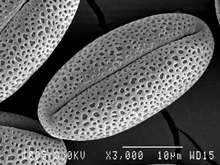Sulcus (morphology)


The term sulcus (pl. sulci) is a general descriptive term for a furrow or fissure. It is used in many disciplines, such as geology, but in morphological and anatomical connections it usually refers to a groove as a feature in the surface of a limb or an organ, notably in the surface of the brain, but also in the lungs, certain muscles (including the heart), as well as in many bones, and various other major morphological features, both internal and external. Many sulci are the product of a surface fold or junction, such as in the gums, where they fold around the neck of the tooth.
The term sulcus is used in invertebrate zoology to describe folds, grooves, and boundaries, especially at the edges of sclerites or between segments.
In botany and palynology, the surface morphology of seeds and pollen grains is termed sulcate if one or more sulci form major features. In the case of pollen, these sulci, called colpi (sing: colpus), are the apertures through which the pollen tube germinates. Smaller furrows may be described by other terms such as rugose, rugulose, plicate, striate, etc.
Examples in anatomy
In the brain
Elsewhere
- anterior interventricular sulcus
- calcaneal sulcus
- coronal sulcus
- femoral sulcus or intercondylar fossa of femur
- gingival sulcus
- gluteal sulcus
- interlabial sulci
- intermammary sulcus
- intertubercular sulcus, the groove between the lesser and greater tubercules of the humerus (bone of the upper arm)
- lacrimal sulcus (sulcus lacrimalis)
- malleolar sulcus
- patellar sulcus or intercondylar fossa of femur
- posterior interventricular sulcus
- preauricular sulcus
- radial sulcus (musculospiral groove)
- sagittal sulcus
- separatoral sulcus (depression behind the brow ridges of some primates)
- sigmoid sulcus
- sulcus arteriæ vertebralis
- sulcus subtarsalis in the eyelid
- sulcus tubae auditivae
- tympanic sulcus
- urethral sulcus, in the baculum (penile bone, found in many mammals but not humans)